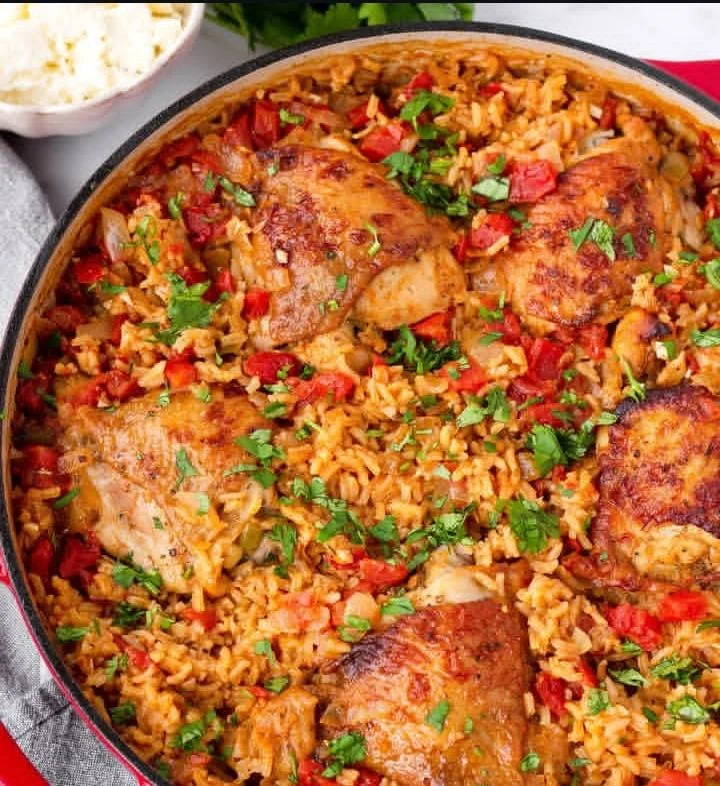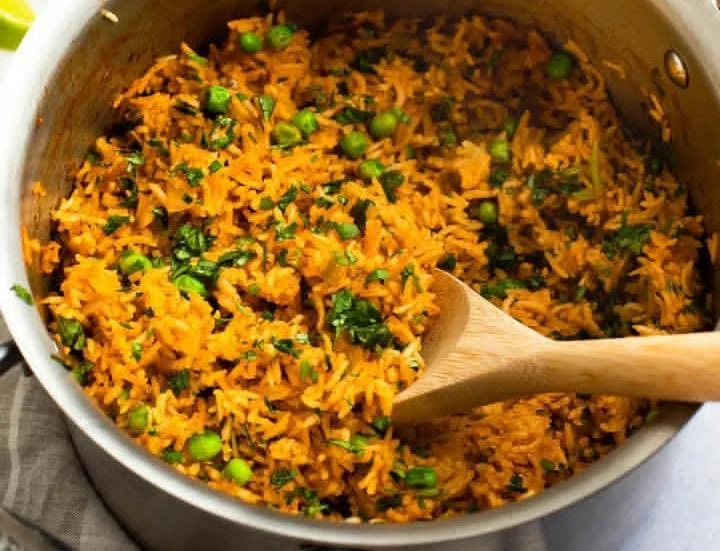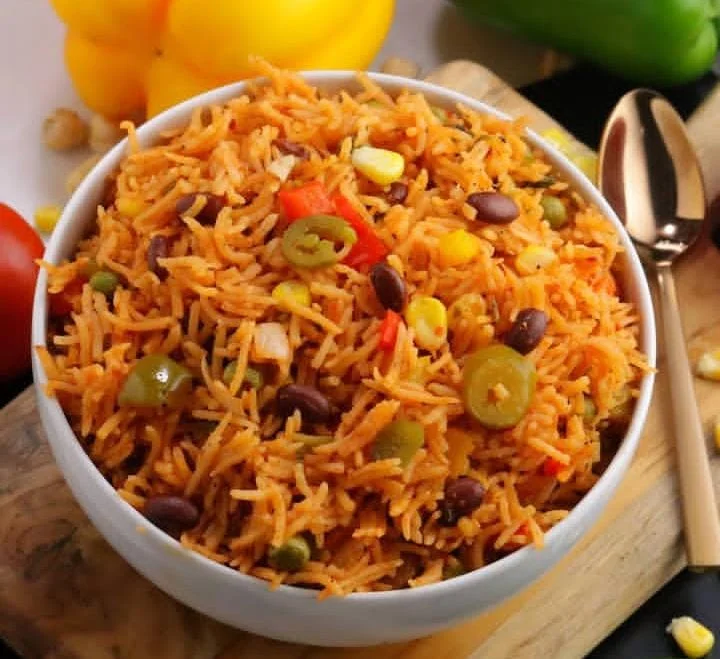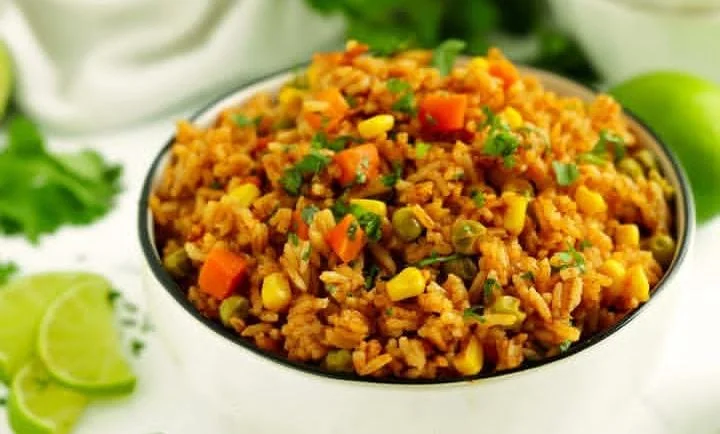Rice Cooker Mexican Rice Instant Pot-Style: Easy, Flavorful, Pinterest-Trending Recipe
Rice cooker Mexican rice is a simple, hands-off way to make vibrant, savory rice that pairs perfectly with tacos, grilled meats, or as a flavorful side dish. This method uses a rice cooker to infuse rice with tomatoes, onions, garlic, and warm spices, producing fluffy grains that carry a rich, slightly tangy tomato flavor.
Because the rice cooker controls heat and timing automatically, this recipe is ideal for busy cooks who want consistent results without constant monitoring. Popular on Pinterest for its simplicity and bright presentation, rice cooker Mexican rice is an approachable recipe for beginners and an easy weeknight staple for families.

In this article you will find a clear explanation of what Mexican rice is, its nutritional profile, a detailed ingredient list with exact quantities, step-by-step preparation instructions tailored for rice cookers, healthy habits to improve the recipe, and several creative variations to suit different dietary needs and flavor preferences. Every section explains not only what to do but why each choice matters, helping you achieve perfect results every time.
What is Rice Cooker Mexican Rice?
Rice cooker Mexican rice is a stovetop-inspired rice dish adapted for an electric rice cooker. Instead of cooking on a pan, ingredients like rice, tomato, onion, garlic, broth, and spices are combined in the rice cooker where the appliance gently simmers and steams the grains. The result is a well-seasoned, slightly reddish rice with individual grains that are fluffy rather than mushy.

This dish differs from Spanish rice and from Mexican rice variations mainly in method and seasoning nuances. Using a rice cooker simplifies the process: the aromatic flavors develop as the rice absorbs the seasoned liquid during the automated cooking cycle. This method minimizes active time and reduces the risk of burning or sticking while delivering a reliably tasty side dish.
Nutrients in Mexican Rice (Per Serving, approx.)
| Nutrient | Approximate Amount |
|---|---|
| Calories | 220 kcal |
| Protein | 4 g |
| Fat | 5 g |
| Carbohydrates | 40 g |
| Fiber | 2 g |
| Sodium | 480 mg |
| Vitamin C | 6% DV |
| Iron | 6% DV |
Main Ingredients

Below is a complete ingredient list with precise quantities and an explanation of the role each ingredient plays. The quantities are scaled to yield a total recipe that serves four as a side.
Ingredient List with Quantities
- Long-grain white rice – 2 cups (uncooked, 400 g)
- Tomato sauce – 1 cup (240 ml)
- Chicken or vegetable broth – 2 cups (480 ml)
- Yellow onion – 1 medium (about 150 g), finely diced
- Garlic – 3 cloves (about 9 g), minced
- Olive oil – 2 tablespoons (30 ml)
- Ground cumin – 1 teaspoon (2 g)
- Paprika (smoked or sweet) – 1 teaspoon (2 g)
- Salt – 1 teaspoon (5 g), adjust to taste
- Black pepper – 1/2 teaspoon (1 g)
- Fresh cilantro – 1/4 cup chopped (about 15 g), for garnish
- Frozen peas and carrots – 3/4 cup (120 g), optional
- Lime juice – 1 tablespoon (15 ml), optional for finishing
Total quantity of the whole recipe: After cooking, the recipe yields about 5 cups (approximately 1100 g) of cooked Mexican rice, suitable for four side-dish servings or three larger portions.
Explanation of Each Ingredient
Long-Grain White Rice
Long-grain rice cooks into separate, fluffy grains when properly measured with liquid. It absorbs flavors well and maintains structure in a rice cooker, making it the preferred choice for Mexican rice. Rinsing the rice removes surface starch that can cause clumping.
Tomato Sauce
Tomato sauce provides the characteristic reddish color and adds concentrated tomato flavor. It is smoother and less acidic than diced tomatoes, which helps maintain a consistent texture in the rice.
Broth
Using chicken or vegetable broth adds savory depth that water alone cannot provide. Broth contributes umami and enriches the overall flavor profile; choose low-sodium broth if controlling salt.
Onion
Onion provides sweetness and aromatic complexity when sautéed briefly before combining with rice. It forms a flavorful base that complements the tomato and spices.
Garlic
Garlic contributes pungency and warmth; minced garlic disperses evenly through the rice and infuses the grains with savory notes.
Olive Oil
Olive oil is used to soften aromatics and coat the rice, which helps prevent sticking and encourages even cooking. It also carries fat-soluble flavor compounds.
Cumin
Cumin adds earthy, warm notes that are central to Mexican-inspired rice. Use ground cumin for an even distribution of flavor.
Paprika
Paprika contributes gentle sweetness and color; smoked paprika adds a subtle smoky dimension that pairs well with grilled meats.
Salt and Pepper
Salt enhances all flavors while pepper adds mild heat. Adjust salt based on broth sodium and personal preference.
Cilantro
Fresh cilantro provides brightness and a herbaceous counterpoint to the savory rice. Add it at the end to preserve its fresh flavor.
Frozen Peas and Carrots (Optional)
These vegetables add color, fiber, and nutrients without changing cooking time significantly when stirred in just after the rice finishes.
Lime Juice (Optional)
A splash of lime brightens the dish, adding acidity that balances the tomato and seasonings without overwhelming the palate.
How to Prepare

The following steps are written for a standard 5-cup rice cooker. If your appliance differs, consult its manual and adjust liquid ratios as needed.
Step 1: Rinse and Prepare Rice
Start by placing the 2 cups of long-grain white rice in a fine-mesh sieve and rinse under cold water until the water runs clear. This removes excess surface starch and helps the grains cook separately rather than clump. After rinsing, drain the rice thoroughly and set it aside.
Step 2: Sauté Aromatics (Optional but Recommended)
If your rice cooker has a sauté function, heat the olive oil and add the diced onion. Sauté for 3 to 4 minutes until the onion is translucent, then add the minced garlic and cook for thirty seconds until fragrant. If your rice cooker lacks a sauté feature, perform this step in a small skillet over medium heat and then transfer the aromatics to the rice cooker.
Step 3: Combine Rice, Tomato Sauce, and Broth
Add the rinsed rice to the rice cooker pot. Pour in the tomato sauce and chicken or vegetable broth, then stir in cumin, paprika, salt, and black pepper. Mix gently to combine, making sure rice is evenly distributed and submerged in the liquid. For added flavor, you can stir in a small knob of butter or a teaspoon of oil.
Step 4: Add Optional Vegetables
If using frozen peas and carrots, add them on top of the rice mixture; they will steam during the cooking cycle and incorporate with minimal stirring. Avoid stirring them into the rice to prevent uneven cooking; instead layer them on top so they soften evenly.
Step 5: Start the Rice Cooker
Close the rice cooker lid and select the normal or white rice setting. Let the rice cooker run a full cycle. Avoid opening the lid during cooking to maintain consistent steaming and prevent heat loss.
Step 6: Rest and Fluff
When the rice cooker signals that cooking is complete, allow the rice to rest with the lid closed for 5 to 10 minutes. This resting period lets excess steam redistribute and ensures fluffy grains. Open the lid and use a fork to gently fluff the rice, releasing steam and separating grains.
Step 7: Finish and Garnish
Stir in chopped fresh cilantro and a tablespoon of lime juice if desired. Taste and adjust seasoning with additional salt or pepper. Transfer the rice to a serving dish and garnish with extra cilantro leaves or lime wedges.

Healthy Habits
Practicing healthy habits enhances both the nutrition and enjoyment of Mexican rice. Choose brown rice or a blend of brown and white rice to increase fiber and nutrients, but remember brown rice requires a longer cooking time and slightly more liquid. Use low-sodium broth to control salt intake and increase water intake with meals to support digestion.
Add more vegetables such as bell peppers, corn, or zucchini to boost vitamins, minerals, and fiber without sacrificing flavor. Incorporate lean proteins like grilled chicken or beans to make the rice a balanced meal. Finally, practice portion control by serving rice alongside vegetables and proteins rather than as the only component of a meal.

Variations of Rice Cooker Mexican Rice
Below are four easy variations that transform the base recipe into distinct dishes. Each variation includes two explanatory paragraphs of five lines each to describe preparation and flavor notes.
Variation 1: Chicken and Bell Pepper Mexican Rice

This variation adds cooked, shredded chicken and sautéed bell peppers to create a one-pot meal with added protein and color. After the rice completes its cycle, gently fold in one cup of cooked shredded chicken and one cup of diced sautéed bell peppers. Return the cooker to warm for five minutes if necessary to heat the chicken through and meld flavors, keeping the texture tender. The bell peppers provide sweetness and vitamin C while the chicken makes the dish more substantial for dinner. Serve with a wedge of lime and a sprinkle of cilantro for brightness and an attractive presentation.
For prep, cook and shred chicken separately or use rotisserie chicken for convenience, then set aside before starting the rice. Sauté bell peppers with a pinch of salt until slightly caramelized to bring out sweetness before adding them to the finished rice. This method keeps the peppers from becoming too soft during the rice cycle and preserves their color. The protein addition makes this variation suitable for meal prep since it reheats well and holds texture in the refrigerator. Adjust seasoning with extra cumin or chili powder if you prefer a bolder, spicier profile that complements the chicken.
Variation 2: Vegetarian Black Bean Mexican Rice
This plant-based variation incorporates black beans and corn to create a fiber-rich, protein-packed side or main. Rinse and drain one 15-ounce can of black beans and stir them into the rice after cooking, along with half a cup of drained corn kernels. The residual heat is usually sufficient to warm the beans and corn; if not, use the rice cooker’s warm setting for a few minutes. Add a squeeze of lime and chopped cilantro to lift the flavors and provide a fresh contrast to the tomato base. This variation is budget-friendly, nutritious, and satisfying even for non-vegetarian eaters.
To build flavor in advance, sauté onions and peppers and add them to the rice cooker before starting the cycle. Use vegetable broth to keep the recipe vegetarian, and consider adding a small amount of chipotle in adobo for smoky heat. Black beans add creamy texture and plant protein, while corn adds sweetness and visual appeal. This version is excellent for lunch bowls served with avocado slices and pico de gallo. It also stores well for meal prep, and flavors often deepen after a day in the refrigerator.
Variation 3: Cilantro Lime Mexican Rice (Copycat Restaurant Style)
For a bright, restaurant-style rice, finish the basic recipe with extra cilantro, lime, and a touch of butter. After fluffing the rice, stir in the zest of one lime, two tablespoons of lime juice, one tablespoon of softened butter, and a generous handful of chopped cilantro. Toss gently until the butter melts and the flavors are evenly distributed, creating a vivid, citrusy finish. This variation highlights fresh herbs and citrus, giving a lively counterpoint to the tomato base that pairs especially well with fish or grilled meats. The added butter lends silkiness and depth, mimicking restaurant preparations.
For the freshest flavor, add the lime and cilantro after the rice has rested five minutes so the citrus aroma remains bright. Use fresh cilantro and avoid cooking it for long to preserve its herbal fragrance and color. Adjust lime to taste; some prefer a more citrus-forward version while others like a subtle brightness. This version is perfect for serving alongside tacos, grilled shrimp, or as a base for burrito bowls. The result is an aromatic, zingy rice that elevates simple meals into memorable dishes.
Variation 4: Mexican Rice with Chorizo and Tomato Roasted Poblano
This bold variation uses cooked chorizo sausage and roasted poblano peppers to add spice, smokiness, and complex savory notes. Cook and crumble 150 g of chorizo in a skillet, remove excess fat, and stir the cooked meat into the rice after cooking. Roast one poblano pepper until charred, peel and dice it, then fold into the rice for a smoky, slightly charred flavor that complements the chorizo. The combination of chorizo and roasted poblano transforms the rice into a hearty main that is satisfying on its own. Garnish with crema or a dollop of sour cream to balance heat and add cooling creaminess.
For convenience, use pre-cooked chorizo or cook a larger batch and freeze for future use; its bold flavor stores well. The smoky roasted poblano adds earthiness and a hint of heat without overwhelming the tomato base. If you prefer less spice, use mild chorizo or remove seeds from the poblano before dicing. This variation is ideal for weekend meals or gatherings where you want a robust, flavorful side that doubles as a main. Pair with simple sides like a crisp salad to contrast the rice’s richness.
Serving Tips and Pairings
Mexican rice pairs beautifully with grilled meats, tacos, enchiladas, and fish. Serve it as a base for burrito bowls or alongside refried beans and a green salad for a balanced plate. For a colorful presentation, mound the rice in a shallow bowl, top with sliced avocado, pickled onions, and a sprinkle of queso fresco.
A wedge of lime and fresh cilantro on the side brightens the flavors and provides a professional touch suitable for entertaining. Leftover rice can be repurposed into stuffed peppers or fried rice with eggs and vegetables to reduce food waste and create new meals.
Equipment and Measurements
Using the right equipment and accurate measurements ensures success with rice cooker Mexican rice. A 5-cup rice cooker is ideal for the quantities listed here, but many modern cookers vary; if yours has a capacity different from 5 cups, scale the recipe proportionally. Accurate measuring cups for rice and liquid are important: use a standard dry measuring cup for rice and a liquid measuring cup for broth and tomato sauce.
A fine-mesh sieve is useful for rinsing rice thoroughly, which removes excess starch and improves grain separation. A small skillet is helpful for sautéing aromatics if your rice cooker lacks a sauté function, and an offset spatula or fork makes fluffing easier. Finally, keep a spoon or spatula dedicated to rice use to avoid damaging nonstick pots.
Troubleshooting and Common Issues
If your rice turns out mushy, it usually means too much liquid or overcooking. For a firmer texture, reduce broth by a few tablespoons next time or use the rice cooker’s quick or less-cooked setting if available.
If rice is undercooked, try adding a small amount of hot broth and running the cooker for an additional cycle or letting the rice steam on warm for fifteen minutes. If rice sticks to the bottom of the pot, ensure you used enough oil and that your rice was rinsed; add a teaspoon of oil next time or use a nonstick spray. If the flavor is flat, adjust seasoning after cooking with lime, salt, or additional spices rather than over-seasoning before cooking.
Meal Prep and Make-Ahead Strategies
Mexican rice is excellent for meal prep because its flavors often deepen after a few hours or overnight. Make a large batch and portion it into individual airtight containers for ready lunches or dinner sides during the week.
Reheat gently in a microwave with a damp paper towel or on the stovetop with a splash of broth to restore moisture. For freezing, cool rice completely, then portion into freezer-safe bags, removing as much air as possible; frozen rice keeps well for up to three months. When planning meals, pair cooked rice with quick protein options like rotisserie chicken, canned beans, or pre-cooked shrimp for fast, balanced plates.
Frequently Asked Questions (FAQ)
Can I use brown rice in a rice cooker Mexican rice recipe? Yes, but brown rice requires more liquid and longer cooking time; use about 2 1/2 cups of broth per 2 cups of brown rice and expect the cycle to take longer. Adjust seasonings accordingly.
What’s the difference between Mexican rice and Spanish rice? The terms are sometimes used interchangeably, but Spanish rice often refers to a tomato-based rice common in Spain with saffron or paprika, while Mexican rice uses tomato, cumin, and cilantro and often serves as a side in Mexican cuisine. Regional variations exist, so recipes often overlap.
Can I make this recipe without tomato sauce? Yes; substitute an equal amount of canned diced tomatoes blended smooth or use a tomato bouillon paste diluted with broth. Each substitute will slightly change flavor and acidity, so adjust with a pinch of sugar or a squeeze of lime as needed.
How do I scale the recipe for larger groups? Multiply ingredients proportionally. Keep the rice-to-liquid ratio consistent and use a larger rice cooker or multiple cookers. Avoid overcrowding a single small cooker.
Flavor Pairings and Beverage Suggestions
Choosing complementary sides and beverages enhances the overall dining experience. For bright, herb-forward rice such as the cilantro-lime variation, pair with grilled fish or shrimp to keep the meal light and fresh. Heavier variations like chorizo and poblano match well with grilled chicken or steak. For beverages, light Mexican lagers, crisp Sauvignon Blanc, or zesty rosé complement the tomato and spice notes; non-alcoholic options include agua fresca made with pineapple or cucumber-lime agua fresca for a refreshing accompaniment. A simple horchata or iced tea also balances the spices while keeping the meal family-friendly.
Conclusion
Rice cooker Mexican rice is a practical, flavorful, and adaptable dish that simplifies Latin-inspired cooking without sacrificing taste. By following the ingredient measurements and method above, you can create consistently good rice with minimal effort. Experiment with the provided variations to tailor the dish to your dietary needs and flavor preferences.
With healthy habit tips and proper storage, this recipe becomes a reliable weeknight staple that supports balanced meals. Enjoy the convenience of the rice cooker while serving a vibrant, satisfying dish that becomes even better with practice.






